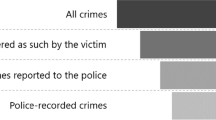Abstract
Maltz and Targonski (2002) have provided an important service by disaggregating the county level data to help researchers examine measurement errors in the county level data, but their conclusion that county-level crime data, as they are currently constituted, should not be used, especially in policy studies is not justified. All data has measurement error, presumably even their measures of this error. Unfortunately, however, Maltz and Targonski provide no systematic test for how bad the data are. Their graphs obscure both the small number of counties affected, that these are rural counties, and that just because some of the population in a county is not represented in calculating the crime rate, that is not the same thing as showing that the reported number is in error. Nor do they provide evidence for the more important issue of whether there is a systematic bias in the data. The evidence provided here indicates right-to-carry laws continue to produce substantial reductions in violent crime rates when states with the greatest measurement error are excluded. In fact, restricting the sample results in somewhat larger reductions in murders and robberies, but smaller reductions in aggravated assaults.
Similar content being viewed by others
REFERENCES
Black, D. A., and Nagin, D. S. (1998). Do right-to-carry laws deter violent crime? J. Legal Studies 27: 209–220.
Klepper, S., and Leamer, E. E. (1984). Consistent sets of estimators for regressions with errors in all variables. Econometrica 52: 1021–1047.
Leamer, E. E. (1978). Specification Searches: Ad Hoc Inferences with Nonexperimental Data, New York: John Wiley and Sons.
Lott, J. R., Jr., and Mustard, J. B. (1997). Crime, deterrence, and right-to-carry concealed handgun laws. J. Legal Studies 26: 1–68.
Lott, J. R., Jr. (2000). More Guns, Less Crime: Understanding Crime and Gun Control Laws (2nd Ed.), University of Chicago Press, Chicago, IL.
Lott, J. R., Jr. (2001). Guns, crime, and safety: Introduction. J. Law Econ. 44: 605–614.
Lott, J. R., Jr., Plassman, F., and Whitley, J. (2003). Confirming More Guns, Less Crime, Stanford University Law School, forthcoming.
Maltz, M. D., and Targonski, J. (2002). A note on the use of county-level UCR data. J. Quant. Criminol. (September) forthcoming.
Miron, J. A. (2001). Violence, guns, and drugs: a cross-country analysis. J. Law Econ. 44: 615–633.
Moody, C. E. (2001). Testing for the effects of concealed weapons laws: specification errors and robustness. J. Law Econ. 44: 799–813.
Plassmann, F., and Tideman, N. (2001). Does the right to carry concealed handguns deter countable crimes. J. Law Econ. 44: 771–798.
Author information
Authors and Affiliations
Rights and permissions
About this article
Cite this article
Lott, J.R., Whitley, J. Measurement Error in County-Level UCR Data. Journal of Quantitative Criminology 19, 185–198 (2003). https://doi.org/10.1023/A:1023054204615
Issue Date:
DOI: https://doi.org/10.1023/A:1023054204615




